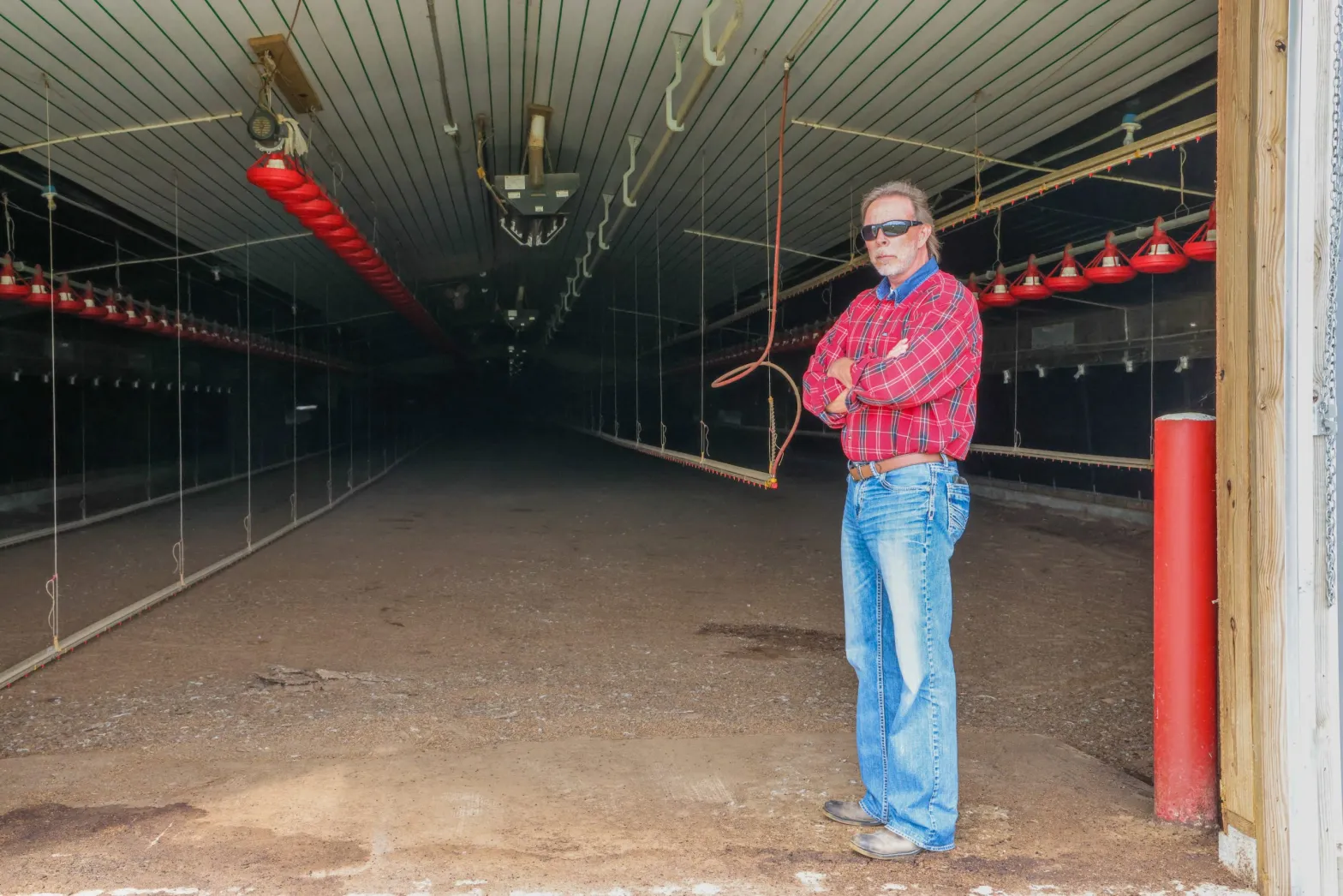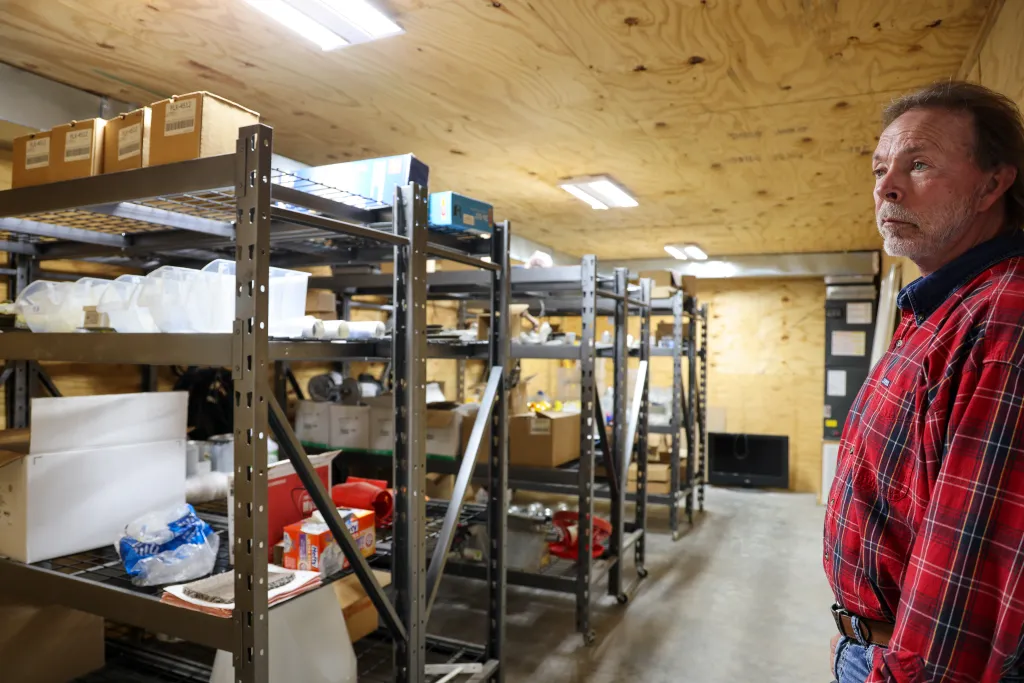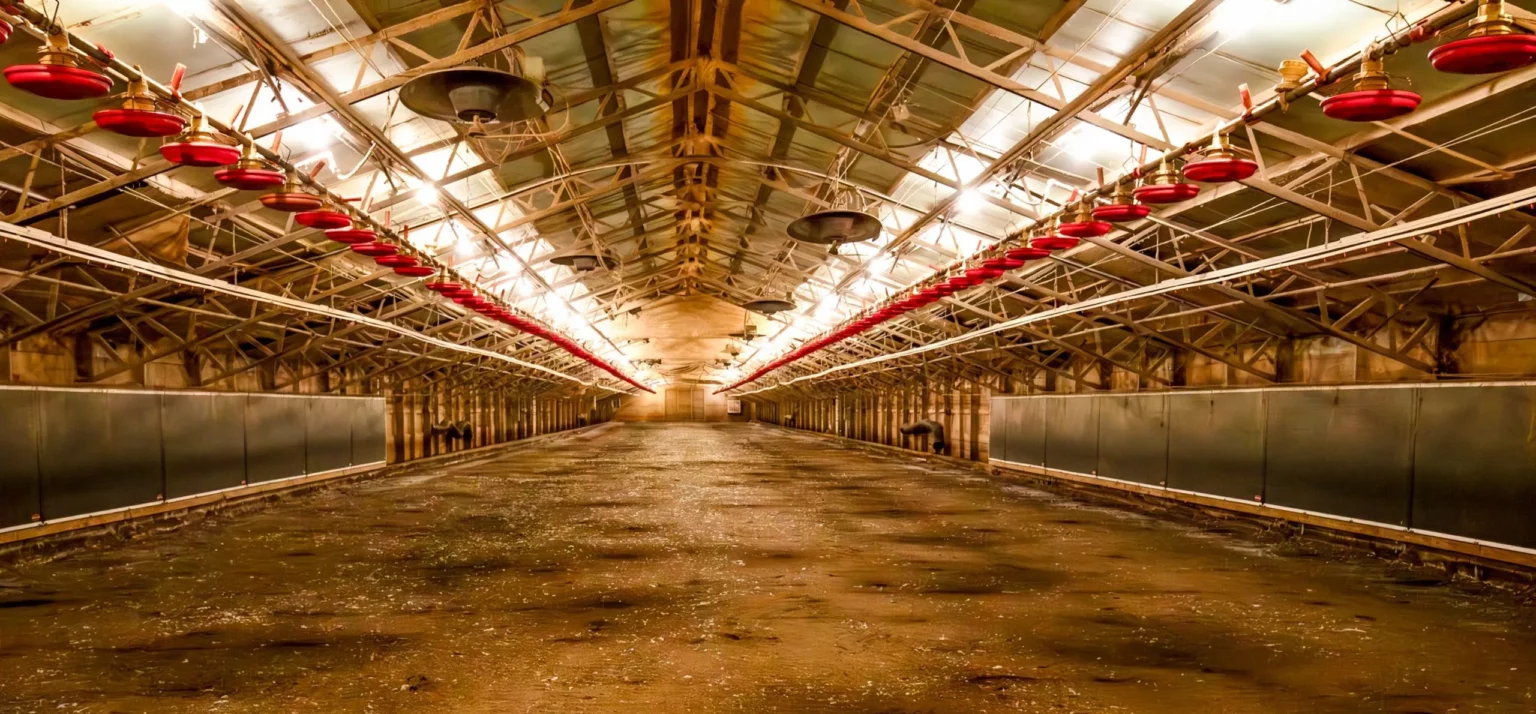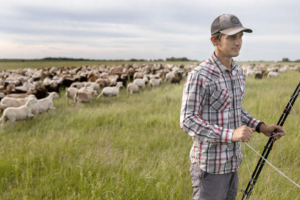10:34
News Story
Chicken farmers stuck with uncertainty, massive loans in wake of Tyson Foods closures
Timothy Bundren must have heard wrong.
The sun wasn’t up yet. He was still groggy from starting his morning routine of walking through chicken barns.
His phone rang and his contact with the global meat company headquartered in Springdale, Arkansas, just two hours south of his farm, started telling him he would no longer be raising chickens.
Bundren, 52, didn’t believe him at first. Just hours later, he was supposed to meet with the bank about another loan to buy the farm down the road. Bundren waited an hour and then called the man back.
The news didn’t change, but the weight sunk in.
Tyson Foods closed four meatpacking plants that day in North Little Rock, Arkansas; Noel and Dexter, Missouri; and Corydon, Indiana. Bundren lives near the plants closed in Missouri and Arkansas. Because of this, the company canceled Bundren’s contract to raise broiler chickens.
But to his knowledge, the chickens Bundren raised weren’t processed at the plants shut down that day. His chickens were shipped to a Tyson plant in Green Forest, Arkansas, just half an hour away and still in operation.
When Tyson closed those regional plants, it had to reassess which growers would send chickens to which plants to meet demand, said Eddie Todd, president of the Missouri-Arkansas Poultry Growers Association and president of the Arkansas Farmers Union.
“The plant that (Bundren) sent his birds to might not have been directly the cause since it didn’t close, but it was because of the other closures and how Tyson looked at all the plants’ feasibility,” Todd said.
Bundren and other growers affected by the closures have been caught in the wake of a larger, company-wide initiative to cut costs. But that has left some growers with more than a million dollars in debt — debt they accumulated at Tyson’s urging — and few options to pay it back, according to growers Investigate Midwest interviewed.
Bundren is $1.4 million in debt. Nine months since that call, his barns are still empty.
While relieved he didn’t sign onto another loan, his world has been turned upside down.
“I’m thinking if I’m hearing this right, I’m out of business,” he said. “How am I going to pay a loan this big back?”
Tyson introduced a restructuring program in 2022 that included consolidating corporate headquarters, reducing expenses and increasing efficiency, according to its filings with the U.S. Securities and Exchange Commission.
“These assets that we’re shuttering would have required significant capital in order to make them competitive,” said Tyson President and Chief Executive Officer Donnie King in an August 2023 investor meeting, the same morning the company announced plant closures across four states. “If you look at the returns on those, it really didn’t make sense to do that.”
The company’s plans came at a human cost. Tyson closed eight meatpacking plants in 2023, six of them chicken processing and two beef processing. It laid off more than 4,200 workers across all of its plants last year.
The company has a lot to gain from its contract growers. In 2023, Tyson Foods had nearly $53 billion in sales — a third of which was from chicken. The company operates 183 chicken facilities across the country, which include processing plants, hatcheries, feed mills and grain elevators. The company’s website states it contracts with more than 3,600 poultry farmers nationwide.
It is unclear how many growers, who are not employees, had contracts with Tyson before the plants closed last year.
But in the counties where Tyson shut down chicken processing plants last year, and where contract growers who spoke to Investigate Midwest operate in, there were a total of 114 broiler chicken farms under production contracts in 2022, according to the USDA’s most recent agricultural census. Many farms raise more than a million birds each year.
Bundren has spent the past six years annually raising about 600,000 broiler chickens, or chickens bred for consumption.
Like almost all broiler chickens in the country, his were raised under contract for a major poultry company. Many chicken growers only grow for a single company as more than half of contract chicken growers live in a region with two or fewer companies, according to a 2012 Journal of Agricultural and Applied Economics study.
“I stand a chance of losing everything. Every (chicken) house I got, all my land, everything,” Bundren said. “It’s throwing me and my family in the street. Tyson ain’t thinking about that, and I guess they don’t care.”
An expensive proposition
From the pivotal early morning phone calls to the millions in debt, former Tyson contract growers who spoke to Investigate Midwest said they have had to take out upwards of $2 million loans to become Tyson contract growers. Their contracts canceled, they’re now saddled with massive debt.
They said the company pushed them to go into more debt to upgrade their barns to meet company demands. Growers also said the company told them that they would be given chickens to raise for as long as they had loans on their barns.
Now that their contracts have abruptly ended, Tyson contract growers said they aren’t able to pay off the debt. Growers are staring down bankruptcy and foreclosures. Some have sold off land or other property to pay off debt while others have retired or looked for work off the farm.
Investigate Midwest spoke to five growers, located in Arkansas, Missouri, Indiana and Virginia, and pored through lawsuits filed by four other contract growers to find how Tyson’s closures have affected the farmers who raise the company’s chickens. A grower in Virginia asked for anonymity because of concerns over breach of contract. Another grower asked to speak on background only, but their situation mirrored that of the other growers.
Tyson did not answer specific questions about the closures, its relationship with contract growers, or how many growers lost contracts due to these closures. In a statement emailed to Investigate Midwest, it said closing plants was not an easy move:
“Tyson Foods is proud to partner with a network of independent growers across the country, and we value the contribution that these growers make to our business. Closing plants is always a difficult decision, and we understand the impact it has on the people and businesses in those communities. We work to help our team members and partners through that transition, and Tyson Foods has provided affected growers with several options to honor our contractual commitments and allow growers to receive fair value.”
Almost a year after the first announcement of Tyson plant closures and canceled contracts, King, Tyson’s president and CEO, said in a February investors meeting that the company is already “seeing the benefits of these actions and we’ll continue to evaluate opportunities to drive efficiency, across our segments.
“The improvements are coming from operational improvements, operational excellence both in plants and in live production and really driving out waste from the business,” King said.
Tyson’s 2023 annual report states it lost $322 million in costs related to closing plants in 2023. One of those costs was contract terminations for chicken growers. The growers that Investigate Midwest interviewed were offered buyouts of their contracts but all stated it would not be enough to cover the entirety of their debt.
Raising poultry is the most expensive type of livestock or animal production farming in the U.S., according to Census of Agriculture data.
The poultry industry was one of the first to introduce the practice of outsourcing debt and risk associated with raising live animals. All major poultry companies use the practice, said Aaron Johnson, a co-policy director at the agricultural reform nonprofit, Rural Advancement Foundation International, or RAFI, headquartered in North Carolina. Tyson owns and delivers the birds to the growers who must put their own money into their operations.
“The model is designed to put that debt load external to the company so that if the company decides to shut down a facility, they are not left holding the bag,” Johnson said. “The contract growers are.”
Tyson’s cost-cutting doesn’t appear to be helping the company’s stock price. Earlier this month, it experienced its worst one-day decline in a year, according to Reuters.
From top grower to empty barns
Six years ago, Bundren moved to rural Harrison, Arkansas, to start growing chickens for Tyson. A former car mechanic, electrician and property manager, he switched careers to put his family into a better financial position and so he could stop working multiple jobs.
Bundren said Tyson verbally promised him years of steady pay if he took out the loans needed to purchase chicken barns. Now, the rug has been pulled out from beneath him.
“They told me point blank that as long as I grow decent birds and do my job, they would keep me in birds long enough to pay my loan off,” Bundren said.
There’s pride in his voice when he talks about his chicken barns and the life he was afforded by raising chickens.
He emphasizes that he always kept his barns clean. Along the dirt road on which his house is located, his driveway is the only one paved.
Chicken growers are generally paid under a system known as the tournament system, a method in which chicken companies rank a grower’s flock of birds against neighboring growers based on the size of the birds and how much feed and other expenses they used. The higher the ranking a contract grower receives, the more money they get. The opposite remains true, though, leaving poultry contract growers susceptible to major swings in pay.
Today, Bundren’s barns are useless. He has no income from poultry farming. The barns he purchased are designed for Tyson chickens, making it difficult to transition to raising poultry for another company.
This is a common experience across the poultry industry. Growers will build or purchase barns with company-specific parameters. In instances where a contract is cut short or growers want to move to a different poultry company, they often are unable to use or sell the equipment and barns they already own, according to a 2006 study in the American Journal of Agricultural Economics.
After the initial shock, Bundren talked to a regional Butterball plant about raising turkeys for the company — only to discover it would cost at least $250,000 to upgrade his barns to its specifications. He said the brunt of the cost was replacing all feed and water lines to be sized for turkeys instead of broiler chickens.
In the end, Bundren said he was unable to raise turkeys for Butterball because his farm is located too close to other poultry operations. He was told this could create a biosecurity risk for the birds.
“Right now I’m scared to death,” Bundren said. “I’m scared I’m gonna lose everything and I made a mistake by putting my family up here.”
Bundren entered the industry at a rough time for growers. In the seven counties in Arkansas and Missouri affected by plant closures, chicken farms were consolidating. From 2002 to 2022, the number of broiler farms under contract was cut in half, according to USDA data.
At the same time, poultry farm debt in Arkansas and Missouri exploded. In Arkansas, the amount of debt and other liabilities held by poultry growers tripled from 2003 to 2022, according to an analysis of USDA farm income data. In Missouri, the figure increased six-fold.
In 2022, the total cost of raising poultry in the country was nearly double that of raising hogs. Poultry is more expensive to raise than dairy cattle, beef cattle, sheep and goats. USDA research shows that raising chickens can also provide less revenue.
Nationally, the cost of raising chickens increased 35% from 2012 to 2022, according to an analysis of Census of Agriculture data. This data does not separate out types of poultry or delineate between the cost of raising chickens for consumption or egg production.
Despite rising costs and debt loads, growers said Tyson continued to ask for upgrades and investments or they would lose their contracts.
Bundren noted growers, if they don’t invest in further upgrades per Tyson specifications, they’re told they won’t receive additional birds. “(Tyson) don’t give a damn about how much money it costs,” he said.
Sleepless nights

Nine months ago, Preston Arnold’s phone rang as he was driving his 1999 white Chevy Silverado to his chicken barns. He pulled over to the side of the road to answer it.
It was his Tyson broiler manager. A few moments into the conversation, Arnold, 67, thought he was joking.
As the man on the phone walked him through the news, Arnold realized he wasn’t.
He looked down the road and saw his eight chicken barns in Sikeston, Missouri. They would soon be empty. He stood to lose everything.
Arnold had been around the chicken industry for years. His brother and father raised birds for Tyson for 25 years while he pursued a career in the insurance industry. He said as he got older, he wanted to travel less and be home more. He bought chicken barns half a mile from his house in Sikeston.
Then, he contracted with Tyson to supply birds for the Dexter, Missouri, slaughter plant 30 minutes away.
For almost five years, he raised close to a million chickens a year for Tyson. When he started as a contract grower in 2019, Arnold’s original loan was for $1.6 million.
As of mid-April, his loan balance sits right around $900,000. His barns now barren.
Arnold said he put his home and property up as collateral for the initial loan. Since the plant’s closure, he said that his bank has threatened foreclosure.
In negotiations with the bank, he said he’s suggested the idea that he keep a barn located at his home throughout the potential foreclosure process, so as to at least have a roof over his head.
“We’ve gone a lot of sleepless nights,” he said. “This has just been a roller coaster of emotions.”
The Farm Service Agency, the federal agency that assists and secures loans for agriculture producers, said in a statement to Investigate Midwest that it has met with Arkansas contract growers who lost Tyson contracts. It has yet to meet with growers in other states, though. The agency said situations like this are why the USDA is examining the treatment of contract growers.
Often, poultry companies will require or strongly encourage growers to upgrade their barns and equipment in order to get more birds to raise, according to USDA research and interviews with contract growers. The USDA estimates that it costs roughly $400,000 to build a new chicken barn, with many growers having multiple barns.
Arnold said in the last two years, he’s invested in upgrading his barns and spent $500,000 on a new one.
“Had I known that there was even talk about (closure), I wouldn’t have (upgraded or built new barns),” Arnold said.
The news of Tyson’s closure blindsided Arnold and other contract growers whose chickens were processed at the Dexter plant. According to two lawsuits filed by four Missouri contract growers, Tyson allegedly planned to shut down the Dexter facility at least a year in advance of the announcement. (Tyson did not respond to a question about the lawsuit’s allegations.)
Despite this, the lawsuits state that the company encouraged contract growers to continue taking out loans and updating facilities. The filings allege that Tyson largely benefitted from the contract operations because it did not have to build or maintain farms that the company would knowingly abandon.
One of the lawsuits was settled out of court for an undisclosed amount of money. Attorney Russell Oliver, who represented the family that settled and still represents the contract growers suing Tyson, declined to comment. The other lawsuit is pending.
“We were not free to seek out other business opportunities on the open market and could only perform this service for the Tyson Companies,” wrote grower Eric Kessler in a signed affidavit from the settled lawsuit. “As such, we are not in ‘business’ for ourselves but were exclusively servants of Tyson.”
The Dexter processing plant was bought by Cal-Maine Foods, the largest egg company in the country, in March. Cal-Maine operates more than 100 production, processing and packing facilities across Arkansas, Missouri, Oklahoma, Ohio, Texas, and much of the South.
The company plans to convert the plant to process egg products and said it will work with some of the region’s former Tyson contract growers to now raise eggs.
Cal-Maine’s vice president and chief financial officer, Max Bowman, said the company has already started placing birds with contract growers in the Dexter area. He declined to say how many new growers used to contract with Tyson, and he declined to say how much money it would cost to convert their operations to meet Cal-Maine’s requirements.
“We’re quite confident that the opportunity we’re going to offer to the growers will be as good as or better than what they had in their former contracts,” Bowman said.
Arnold said the cost to convert his barn to meet Cal-Maine’s specifications was estimated to be at least $550,000 per barn for four barns, meaning he would have to take out another large loan in order to produce eggs for the company. He is still considering taking out a new loan, but has yet to act.
A loan of more than $2 million on top of his other debt is hard to swallow.
“If something doesn’t happen in the way of an FSA debt relief plan or some new legislation, then we’re going to lose everything that we’ve worked our lives for,” he said.
Tyson told growers the company was ‘not going anywhere’

The same morning Arnold pulled over to the side of the road, racking his brain about his next move, Jonathon Morrow answered the phone.
His Tyson service technician told him he was no longer getting birds and the Dexter complex was closing.
Morrow, 60, who raised roughly 1.8 million broilers annually for Tyson, was nonchalant in his response.
“I thought, ‘Yep, I’m losing everything,’” he said.
Following the Great Recession, Morrow started looking for other career paths. After working in construction and roofing for decades, he eventually landed on contract chicken growing for Tyson. In 2013, he said he began to build chicken barns on his family’s farmland in Dudley, Missouri, just outside of Dexter.
Now, he is weighing the options of spending more money to become a contract grower with Cal-Maine, selling the barns, or tearing them down and selling the farmland.
“We went from (360,000 birds a flock) to nothing real quick,” Morrow said.
Morrow had two different contracts to raise two different types of birds for Tyson. He raised broiler chickens in Dudley and breeding chickens in Annapolis, Missouri, more than an hour away.
Morrow, a man of faith with an optimistic demeanor, said he was able to pay off his debt on his barns built for his broiler chickens. But, he said, he is millions of dollars in debt for the barns built for breeding chickens.
Both his broiler contract and breeder contract were canceled by Tyson. The barns have been empty since October 2023. Without a chicken processor in the area, there’s no company to provide him with the birds to occupy them.
“It’s not like you can buy 300,000 chickens on your own and put them in (barns) and find a market,” he said.
In the interim, Morrow has gone back to working construction. On a recent morning call, his laughter was interrupted by the beep of dump trucks.
After the Tyson closure in Dexter, Morrow said he was approached by Cal-Maine to become a contract grower. When he heard that it would take nearly a million dollars for him to meet their specifications, he said he was brutally honest with the company.
“I said, ‘If you think a bank would even loan us more money after this, you’ve lost your mind,’ ” he said. “ ‘And if you think I would be stupid enough to borrow almost another million dollars after this, you’ve lost your mind.’ ”
The agency is currently finalizing a rule proposal internally that will address “certain problematic practices” such as the requirement for additional capital investments in poultry production facilities and equipment. This effort is part of the agency’s ongoing updates to the 100-year-old legislation known as the Packers and Stockyards Act.
The act, created in 1921, is supposed to protect members of the livestock, meat and poultry industries from “unfair, unjustly discriminatory or deceptive practice.”
The USDA finalized a new rule under the act in February that is supposed to give chicken growers more transparency in their contracts and an understanding of how exactly they are paid. In March, a separate ruling to prevent discriminatory practices was finalized and became law on May 6.
“Like with starting any new business, chicken farmers typically incur some debt to get their chicken houses built and their farms up and operational,” said Tom Super, National Chicken Council senior vice president of communications, in a statement to Investigate Midwest. “But chicken farmer loan performance data show more consistent payments and one of the lowest loan default rates in all of agriculture. Raising chickens under contract is one of the best and most reliable sources of cash flow that helps keep families on the farm.”
The National Chicken Council is an industry group that promotes the sale of chicken in the U.S. and whose board members include executive leaders of several major poultry processors.
Morrow said he knew the risks of such a large loan when he became a contract grower. But he, just like other growers, was told that if he does a good job, the company was “not going anywhere.”
“Somebody higher up the food chain had to know this was a possibility,” Morrow said. “Yet they’re (still) giving out contracts to build new (chicken) houses.”
A waiting game
In Arkansas, Bundren’s six chicken barns are remain empty as he negotiates with the bank and the FSA about how to handle his debt. His barns were once a source of steady income, but now the empty metal husks are a reminder of the debt he carries.
“(The barns) are worth zero now,” he said. “When you’ve got a contract, they’re worth $200,000-$300,000 used, a piece.”
Now, it’s a waiting game for Bundren. His wife has started looking for work and interviewing for jobs. He is now doing landscaping, excavation and stump grinding to pay bills.
He said the bank has been working with him to repay the loans and, after some conversations with the FSA, he feels hopeful the agency will help him find a way to manage the financial burden.
Still, his debt of more than a million dollars weighs on him. This past December, while uncertain whether he could keep his house, he tried to have a normal Christmas for his two daughters.
That uncertainty has turned to frustration when he thinks of the money and time he put into making his barns the perfect place to raise Tyson chickens.
“The mental stress is killing me,” Bundren said. “I still don’t know if I’m going to get to keep anything.”
If he keeps his land and avoids foreclosure, Bundren said he may tear down the barns.
“I don’t want to grow birds anymore anyway,” he said. “You just can’t trust Tyson.”
This article first appeared on Investigate Midwest and is republished here under a Creative Commons license.
Our stories may be republished online or in print under Creative Commons license CC BY-NC-ND 4.0. We ask that you edit only for style or to shorten, provide proper attribution and link to our website. AP and Getty images may not be republished. Please see our republishing guidelines for use of any other photos and graphics.





